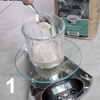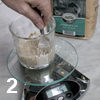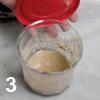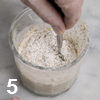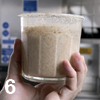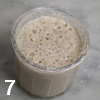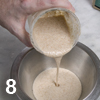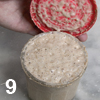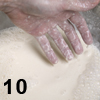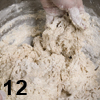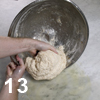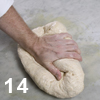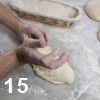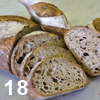Bread from leaven
Using a natural leaven rather than brewer's yeast to make bread gives it a much better taste. The term "sourdough" can be quite confusing, because loaves made with a leaven may have a faint but pleasant acidity or be quite lemony or, in the case of many central European loaves, be both dense and acid.
The naturally leavened loaf that many restaurants prefer (if they can obtain it), is a mildly tangy one, with a slightly sticky crumb around a network of smaller and larger holes. This is bread that doesn't stale for days, toasts exceptionally well, and looks great when sliced.
To make it, chefs have to forget the basic bread-baking rules they may have learnt at college, the ones that are about critical dough temperatures, kneading for a quarter of an hour or tearing the dough to make it more stretchy.
When Dan Lepard prepares his naturally leavened bread, he works with a very slack dough that he stretches with no more than a minimum kneading.
Preparing A Leaven Or "Starter"
A five-, six- or seven-day cycle Once you've made it, your starter will live indefinitely, providing you continue feeding it regularly. As long as you refresh the flour and water every day it will ferment, although it can take two or three days longer than as described below.
Before you start
- Work at a comfortable ambient temperature, under 25°C.
- You'll need a lidded container, its size dependent on the amount of starter you're preparing.
- Choices of flour. Follow the advice below to get started. Once you gain experience you can change the blend of flour varieties or work with just white flour if you prefer.
- Adding raisins or other dried fruit to a starter may change its character, but is otherwise unnecessary.
- The naturally occurring yeasts and bacteria already in the flour will ferment it, so there's no need to add commercial bakers' yeast.
- Weigh all ingredients. Don't guestimate if you want to obtain a consistent product.
- Check water temperature. Anything between 20 and 25°C is fine.
How much leaven to prepare? Once active, even a small amount of leaven will be able to convert a very large quantity of new flour and water into fresh leaven overnight. If you treble the quantities given below, you'll have enough to make a 2kg dough.
Lepard says that, as a rule of thumb, 50g of old leaven will be enough to turn 1kg of 50:50 flour and water into bubbling, healthy leaven over 24 hours. So just start a culture using the quantities given below then, once it's bubbling, use it to ferment an amount suitable for your baking needs.
Day One
Ingredients
50ml tepid water
25g rye flour
Method
Measure the water. Put it in a 500ml jar or similar container. Stir in the flour. Cover. Leave 24 hours at room temperature (1 & 2).
Day Two
When you open the jar, you'll see that some separation has occurred. There's a glossy, watery film on the surface, with silt at the bottom of the jar (3). If you smell the contents you may perceive a hint of fermentation.
Ingredients
50ml tepid water
25g rye flour
Method
Add the water to the jar and its contents. Stir in the flour. Cover. Leave 24 hours at room temperature.
Day Three
When you open the jar, look around the edges and you'll notice tiny bubbles like those that form on the inside of a Champagne glass. These show that the fermentation, caused by the yeasts and bacteria, is well under way (4).
Ingredients
100ml tepid water
50g rye flour
Method
Add the water to the jar and its contents. Stir in the flour (5). Cover. Leave 24 hours at room temperature.
Note: Because the yeasts and bacteria are multiplying and need food, you have to add the extra "food" (more flour) for them.
Day Four
When you open the jar, you'll notice a cappuccino effect with a thick frothy top to the leaven (6 & 7).
Ingredients
100ml water
80g rye flour
Method
Stir the contents of the jar. Discard four-fifths of the contents (8). Stir in the water. Stir in the flour, cover and leave 24 hours.
Day Five
The contents of the jar are bubbling away, thoroughly activated, maybe even spilling over the sides (9). If it looks less active, continue to refresh it to encourage the fermentation.
Ingredients
100ml water
80g rye flour
Method
Discard four-fifths of the contents. Stir in the water and the flour. Cover and leave 24 hours.
It's a good idea to continue feeding and refreshing it for at least one more week before you start making bread with it. You can tell when it's ready if it doubles in volume 12 hours after refreshment. Once it's ready it needs to be refreshed every day by discarding four-fifths and feeding it with flour and water to keep it alive and healthy. This is what French craft bakers call their "chef".
When you make the following loaves, keep back about one-fifth of the starter and feed it enough flour and water to bring it back to its original quantity. Cover it and retain until the next baking session. The starter should always be renewed every 24 hours to maintain its highly active state.
To make the bread
The following recipe is designed to produce a loaf with an open texture - one with lots of air pockets in it, rather than the typical British, close texture with an even crumb.
Enough for 2kg dough: one large loaf, two 800g or three 600g loaves, or about 36 rolls.
It takes up to 24 hours, but isn't time-consuming. In a typical working kitchen, chefs might mix the dough before service on the evening of day one and complete the process in the morning of day two before midday.
Ingredients
475g bubbling active leaven
550ml water at 20°C
650g strong white flour
225g strong wholemeal flour or spelt
50g wholemeal rye flour
20g fine sea salt
2-3tbs oil (sunflower or olive)
Method
Day one
Stir the leaven and water together until it forms a consistent "soup" (10). Combine the flours and salt (11). Mix the ingredients together to form a sticky mass (12).
Leave 10-15 minutes to stand, to allow gliadin and glutenin proteins in the compound gluten to hydrate and bond.
Spread a little oil on the work surface, on your hands and on top of the dough.
Scrape the dough, working from the side of the bowl, on to the oiled surface (13). Knead briefly - 20 to 30 seconds will be enough. Flatten lightly and fold back into shape. Put back into the mixing bowl (14). Cover and leave overnight at 4-6°C.
Note: If you're using a machine, combine ingredients and mix at slow speed for one or two minutes, then rest 15 minutes. Mix at a slightly higher speed for a further two minutes. Cover and refrigerate overnight.
Day two
Scrape the dough on to a lightly oiled work surface and pat it out to form a rectangle, roughly 40cm x 20cm. Fold one end, a third of the length, back to the centre.
Fold the other end back over it, so you have three layers - think puff pastry. Pat it out again and fold it once more. This stretches the dough and aerates it. Leave one hour at room temperature (20-25°C) and repeat. Leave another hour and repeat. The dough should be rising nicely. The most important thing to remember is that it's ready to shape when bubbles form in the dough.
To check, slash the dough with a sharp knife. If this hasn't happened, leave the dough a further hour and check again.
Divide the dough into the loaf sizes. Shape into balls on a lightly floured surface. The most effective way of doing this is to flatten the edge of the dough, fold it back towards the centre, turn it and repeat until the dough is round, then shape it into a ball, handling as little as possible (15). Rest again for 20 minutes.
For an elongated Vienna loaf shape, extend the ball, rolling it lightly by hand. Pull a flap of dough over as though you were making a pasty and seal with the heel of the hand. Repeat along the length of the dough.
Because the dough is so soft, the loaves must do the last part of the rising in liberally floured cloth-lined baskets. Turn the shaped loaves into the baskets with the seams up and leave them to finish rising. They're ready for baking when they've doubled their size, in two to three hours (16). If you don't have baskets, line appropriate mixing bowls or tins with well-floured tea towels.
Preheat the oven to 220°C. Turn the loaves on to floured baking sheets (17), so that any seams are now underneath. Bake for 25 minutes. Open the oven doors to allow any trapped steam to escape then shut the oven door and continue to bake until the loaves are ready, for about 30-45 minutes, depending on their size. With a large 2kg loaf, reduce the temperature after the first 30 minutes to 180°C and bake longer. Remove from oven and cool on a cooling wire.
A naturally leavened bread should not be eaten warm or hot. Leave to cool before serving.
Varying the starter
- Lepard's standard mixture for a leaven that provides the best balance in a loaf between sourness and elasticity is seven parts white bread flour, two parts wholemeal, one part rye.
- Dried fruit is said to speed the fermentation.
- Yogurt mixed with the water may remove the risk of stray, unpleasant-smelling yeasts.
- The choice of flours will affect the eating quality of the loaf, but all flours will ferment when combined with water.
Varying the liquid Instead of 550ml water, Lepard recommends 150ml dark ale mixed with 400ml water.
Varying the texture The less strong white flour there is in the mixture the denser it will be, and rye, in particular, gives a compact texture (18).
Dan Lepard A member of the National Association of Master Bakers, Dan Lepard was originally - and still is - a professional photographer (he's doing the photography for Giorgio Locatelli's soon-to-be-published book).
His way into baking may have been through Alastair Little's back door (he had no formal training) but spells with John Torode at Mezzo, Fergus Henderson at St John and Locatelli turned him into a stylish, professional baker.
His passion, curiosity and skill have taken him to a higher level still, where he is recognised as the most knowledgeable baker of naturally leavened bread in the country. His book Baking with Passion (Quadrille 1999) won a Guild of Food Writers Cookery Book of the Year 2000 award. In 2004, The Handmade Loaf (Mitchell Beazley) was shortlisted for a World Food Media Award.
Lepard works with bakeries and chefs throughout the world, helping them to make the best bread possible, and is a consultant to industry supplier Bakehouse, which specialises in bake-off croissants, sweet and savoury pastries, and speciality bread.



